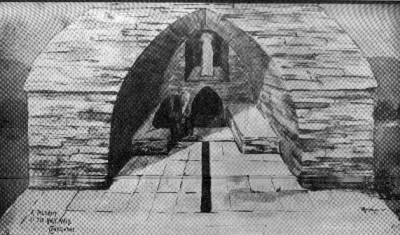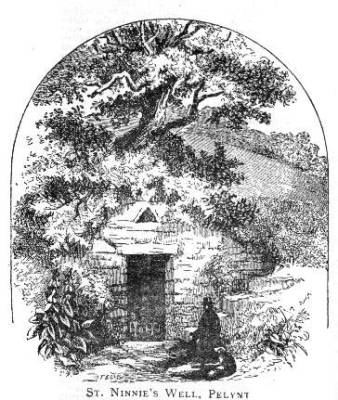
Saints, Mermaids & Phoenicians Contents
Some facts and legends on Cornish Wells
No. 1. St Constantine's Well, Harlyn Bay.

A Pilgrim at the Holy Well at Harlyn Bay.
Buried under the sands at Harlyn Bay is the well of St Constantine. It
was near the ruins of a chapel on the edge of the little stream that drains the
valley. Hals the historian saw it in the seventeenth century and described it as
follows. “Near this church is yet extant St. Constantine’s well, strong
built of stone and arched- over; on the inner part hereof are places or seats
for people to sit and wash themselves in the streams thereof; the consequence of
which facts, if the inhabitants may be credited, is not only very refreshing and
salubrious, but, if it be dry weather, immediately showers of rain will
follow.”
This belief (which has inspired the story invented or recorded by Hunt in his Popular Romances of the West of England, pp. 287, 8) is particularly interesting,
The well of St. Constantine was overwhelmed in the sand in the eighteenth
century and buried. 8 feet deep. In 1911 Mr. Penrose Williams excavated it and
found it exactly as Hals described it, except that the roof had partly been
destroyed. (1). There is a stone seat on either side, about a foot high, 16
inches wide, and 3 feet long, running along each side wall. At one end is the
well, the water of which escapes down a gully in the floor between the-seats.
When unearthed this gully was floored. with an oak trough. “The side walls
gradually curve inward and would meet at a point about seven feet from the
floor.” Mr. Williams completely uncovered the well in 1923, and protected it
with a temporary roof. He thinks that it originally stood on the banks of a
little estuary, which would account for the position of the church on this
otherwise unlikely spot. The neighbourhood, now so thinly inhabited, was-a
centre of population in very early times.
In 1866 two beautiful gold Lunulae together with a flat bronze celt were
found in a Barrow on the cliff near Harlyn House. These Lunulae and Celt belong
to’ the early Bronze Age, dating before 1000 B.C. They may be seen at the
County Museum. Truro.
In 1900 there
was a further find of a Prehistoric Burial Ground at Harlyn Bay. The interment, were of what
is known as contracted or ‘crouched’ type, similar to the Egyptian and very
rare in Britain. The cists were made of slate. This Cemetery is believed to be
of the Early Iron Age with an approximate date of the 3rd century B.C. Ornaments
were found in the Cists, including a pair Bronze Fibulae and bracelets of Bronze
and Kimmeridge shale. These may also be seen in the County Museum, in Truro.
The Festival of St. Constantine (March 9) was, kept at St. Merran until
around 1930 by an annual hurling match, on which occasion the owner of Harlyn
had, from time immemorial, supplied the silver ball. We are informed from good
authority that a shepherd’s family, of the name of Edwards, held one of the
cottages in Constantine for many generations under the owner - of Harlyn, by the
annual render of a Cornish Pie, made of limpets, raisins, and sweet herbs, at
the feast of St. Constantine.”
(I) See his reports in Proceedings of the Society of Antiquaries for 1912. and in the Journal of The Royal Institution of Cornwall. 1924.

No.2
In
Pelynt parish about 2 miles from the church is a place called Ninnies or St.
Ninnies, where is an interesting little building of 15th century date called St.
Nun’s Well. Near it was a chapel of the Saint. In the 12th century, this
chapel, with its adjacent lands, was given by a Lord of Trelawne to the great
Abbey of Wilton, near Salisbury. In 1242 we find Andrew de Cardinan, Lord of “Trowloen,”
releasing “Alice, Abbess of Wilton, from all obligation to do service to him
for land belonging to the chapel of St. Nenina the Virgin.
In
1337 and 1339 the Chapel is called “Sancta Nenyna” or “Nynna,” and in
1340 we read of the parish church of Plenynt with the chapel of Sancta Neomena.
Finally, in 1409 the Register of Bishop Stafford records the interesting fact
that John Bele was collated (by lapse) to the Chantry Chapel of Sancta Nynnina.
In 1414 he became Vicar of Pelynt.
There
was another shrine of St. Non or Nonita in the parish of Creed. At Trevillick, a
1ittle north of Grampound in that parish is a field called Senaunter or St.
Naunter, in which stood a chapel and holy well of which there are no remains,
save a small stone arch now built into an outhouse at Trevillick. Tonkin writing
in 1730 refers to “ Trevillick . . . where is a ruined chapel and
At Cuby or Tregony Church, three miles from Grampound, is the well-known inscribed stone of (1) 7th century date built into the west end of the south aisle. The legend upon it in debased Roman characters runs Nonnita Ecilini Rigati Tris Fili Ercilinci, i.e. “In memory of Nonnita, Ercilinus, and Rigatus the three sons of Ercilincus.” It is exceedingly interesting to find the name Nonnjta used for a man on a stone that must date from the age of the Saints.
The Holly Well of S. Nonna at Altarnon was one
of the most famous in Cornwall and like the Camborne well it had the reputation of being able to cure
Insanity. Cornish Historian Carew wrote
an amusing description of scenes formerly witnessed at this well he says: “In
our forefathers’ days, when devotion as much exceeded knowledge, as knowledge
now cometh short of devotion, there were many bowssening places for curing mad
men, and amongst the rest, one at Alternunne
called S. Nunn’s Pool. . . . And because the manner of this bowssening
is not so unpleasant to hear, as it is uneas,y to feel, I will (if you please)
deliver the practice as I received it from the beholders. "
"The, water running from S. Nunn’s well fell into a square and
close-walled plot, which might be filled at what depth they listed. Upon this
well was the frantic person set to stand, his back turned toward the pool, and
from thence, with a sudden blow in the breast, tumbled headlong into the pond;
where a strong fellow, provided for the nonce, took him, and tossed him up and
dawn, amongst and athwart the water, until the patient, by foregoing his
strength, had somewhat forgot his fury. Then was he conveyed to the church, and
certain masses sung over him; upon which handling, if his right wits returned,
S. Nun had the thanks; but if there appeared small amendment, he was bowssened
again and again, while there appeared in him any hope of life, or recovery.”
According
to Baring Gould there is a Holy Well of St. Nun. at Rosteage in Gerrans. The
well, however, though of ancient appearance, is really modern. The granite arch
above it came from the old mansion, and the name of St. Nun’s Well was
some romantic visitor of modern
times.
There
is another
so-called Nun’s Well
at Carnanton in Mawgan, and its venerable building is likewise “made up” of
pieces of the old mansion.
3.